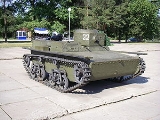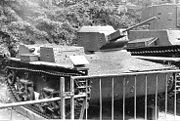
T-38
Encyclopedia
The T-38 amphibious scout tank was a Soviet
amphibious
light tank
that saw service in World War II
.
, based in turn on the French AMR 33
light reconnaissance tank. The tank was powered by a standard GAZ
(Ford) engine and was cheap to produce. Buoyancy was achieved by the large-volume hull and large fenders. In water, the vehicle was propelled by a small three-bladed propeller mounted at the rear.
The tanks were intended for use for reconnaissance and infantry support. As a scout tank the T-38 had the advantages of very low silhouette and good mobility through its ability to swim. The T-38 was also intended to be air-portable; during the Kiev
maneuvers in 1936, the tanks were transported by Tupolev TB-3
bombers, mounted under the fuselage. Infantry battalions were each issued 38 T-38s, with 50 being designated for each airborne armored battalions. However, the thin armor
and single machinegun armament made the tank of only limited use in combat while the lack of radios in most T-38s was a serious limitation in a reconnaissance vehicle. The T-38's limitations were recognized, and it would have been replaced by the T-40
, but the outbreak of the Second World War meant that only a few T-40s were produced.
Around 1,500 T-38s were built, illustrating the importance of amphibious scout tanks to the Red Army. Some were up-gunned with a 20 mm ShVAK cannon, and designated the T-38RT.
 The tank served with the Red Army
The tank served with the Red Army
in the Winter War
with Finland
in 1940, but was unsuccessful due to its light armament and thin armour, which was easily penetrated by rifle and light machine gun
fire. In the confined terrain of Finland, the tank was a deathtrap; it also did not do well in the early stages of World War II, and large numbers were captured by the Germans during Operation Barbarossa
. The T-38 was rarely seen in direct combat after 1941 and mostly relegated to other roles such as artillery tractor
, although it was reported to have been used in the Dnieper River
crossing of 1943. During World War II, the main amphibious scout vehicle of the Red Army was the Ford
GPA amphibious jeep, an open unarmored vehicle provided through Lend-Lease
.
The German Army did not generally use captured T-38s as gun tanks (unlike captured T-26
s, T-34
s, or other more valuable vehicles). It is reported that some were re-used by converting them into self-propelled anti-aircraft artillery, mounting a 37 mm anti-aircraft gun on the T-38 chassis, although this would seem to be a very large piece for the chassis.
Soviet Union
The Soviet Union , officially the Union of Soviet Socialist Republics , was a constitutionally socialist state that existed in Eurasia between 1922 and 1991....
amphibious
Amphibious vehicle
An amphibious vehicle , is a vehicle or craft, that is a means of transport, viable on land as well as on water – just like an amphibian....
light tank
Light tank
A light tank is a tank variant initially designed for rapid movement, and now primarily employed in low-intensity conflict. Early light tanks were generally armed and armored similar to an armored car, but used tracks in order to provide better cross-country mobility.The light tank was a major...
that saw service in World War II
World War II
World War II, or the Second World War , was a global conflict lasting from 1939 to 1945, involving most of the world's nations—including all of the great powers—eventually forming two opposing military alliances: the Allies and the Axis...
.
History
Designed in 1934–36 by N. Astrov's bureau at Factory No. 37 in Moscow, the T-38 was a development of the earlier T-37T-37 tank
The T-37A was a Soviet amphibious light tank. The tank is often referred to as the T-37, although that designation was used by a different tank which never left the prototype stage.The T-37A was the first series of mass-produced fully amphibious tanks in the world.The tank was first created in...
, based in turn on the French AMR 33
AMR 33
The Automitrailleuse de Reconnaissance Renault Modèle 1933 was a French light tank developed during the Interbellum and used in the Second World War....
light reconnaissance tank. The tank was powered by a standard GAZ
GAZ
GAZ or Gorkovsky Avtomobilny Zavod , translated as Gorky Automobile Plant , started in 1932 as NAZ, a cooperation between Ford and the Soviet Union. It is one of the largest companies in the Russian automotive industry....
(Ford) engine and was cheap to produce. Buoyancy was achieved by the large-volume hull and large fenders. In water, the vehicle was propelled by a small three-bladed propeller mounted at the rear.
The tanks were intended for use for reconnaissance and infantry support. As a scout tank the T-38 had the advantages of very low silhouette and good mobility through its ability to swim. The T-38 was also intended to be air-portable; during the Kiev
Kiev
Kiev or Kyiv is the capital and the largest city of Ukraine, located in the north central part of the country on the Dnieper River. The population as of the 2001 census was 2,611,300. However, higher numbers have been cited in the press....
maneuvers in 1936, the tanks were transported by Tupolev TB-3
Tupolev TB-3
The Tupolev TB-3 was a heavy bomber aircraft which was deployed by the Soviet Air Force in the 1930s and during World War II. It was the world's first cantilever wing four-engine heavy bomber. Despite obsolescence and being officially withdrawn from service in 1939, TB-3 performed bomber and...
bombers, mounted under the fuselage. Infantry battalions were each issued 38 T-38s, with 50 being designated for each airborne armored battalions. However, the thin armor
Vehicle armour
Military vehicles are commonly armoured to withstand the impact of shrapnel, bullets, missiles, or shells, protecting the personnel inside from enemy fire. Such vehicles include tanks, aircraft, and ships....
and single machinegun armament made the tank of only limited use in combat while the lack of radios in most T-38s was a serious limitation in a reconnaissance vehicle. The T-38's limitations were recognized, and it would have been replaced by the T-40
T-40
-External links:* on Battlefield.ru...
, but the outbreak of the Second World War meant that only a few T-40s were produced.
Around 1,500 T-38s were built, illustrating the importance of amphibious scout tanks to the Red Army. Some were up-gunned with a 20 mm ShVAK cannon, and designated the T-38RT.
Service history

Red Army
The Workers' and Peasants' Red Army started out as the Soviet Union's revolutionary communist combat groups during the Russian Civil War of 1918-1922. It grew into the national army of the Soviet Union. By the 1930s the Red Army was among the largest armies in history.The "Red Army" name refers to...
in the Winter War
Winter War
The Winter War was a military conflict between the Soviet Union and Finland. It began with a Soviet offensive on 30 November 1939 – three months after the start of World War II and the Soviet invasion of Poland – and ended on 13 March 1940 with the Moscow Peace Treaty...
with Finland
Finland
Finland , officially the Republic of Finland, is a Nordic country situated in the Fennoscandian region of Northern Europe. It is bordered by Sweden in the west, Norway in the north and Russia in the east, while Estonia lies to its south across the Gulf of Finland.Around 5.4 million people reside...
in 1940, but was unsuccessful due to its light armament and thin armour, which was easily penetrated by rifle and light machine gun
Light machine gun
A light machine gun is a machine gun designed to be employed by an individual soldier, with or without an assistant, as an infantry support weapon. Light machine guns are often used as squad automatic weapons.-Characteristics:...
fire. In the confined terrain of Finland, the tank was a deathtrap; it also did not do well in the early stages of World War II, and large numbers were captured by the Germans during Operation Barbarossa
Operation Barbarossa
Operation Barbarossa was the code name for Germany's invasion of the Soviet Union during World War II that began on 22 June 1941. Over 4.5 million troops of the Axis powers invaded the USSR along a front., the largest invasion in the history of warfare...
. The T-38 was rarely seen in direct combat after 1941 and mostly relegated to other roles such as artillery tractor
Artillery tractor
Artillery tractor is a kind of tractor, also referred to as a gun tractor, a vehicle used to tow artillery pieces of varying weights.-Traction:...
, although it was reported to have been used in the Dnieper River
Dnieper River
The Dnieper River is one of the major rivers of Europe that flows from Russia, through Belarus and Ukraine, to the Black Sea.The total length is and has a drainage basin of .The river is noted for its dams and hydroelectric stations...
crossing of 1943. During World War II, the main amphibious scout vehicle of the Red Army was the Ford
Ford Motor Company
Ford Motor Company is an American multinational automaker based in Dearborn, Michigan, a suburb of Detroit. The automaker was founded by Henry Ford and incorporated on June 16, 1903. In addition to the Ford and Lincoln brands, Ford also owns a small stake in Mazda in Japan and Aston Martin in the UK...
GPA amphibious jeep, an open unarmored vehicle provided through Lend-Lease
Lend-Lease
Lend-Lease was the program under which the United States of America supplied the United Kingdom, the Soviet Union, China, Free France, and other Allied nations with materiel between 1941 and 1945. It was signed into law on March 11, 1941, a year and a half after the outbreak of war in Europe in...
.
The German Army did not generally use captured T-38s as gun tanks (unlike captured T-26
T-26
The T-26 tank was a Soviet light infantry tank used during many conflicts of the 1930s as well as during World War II. It was a development of the British Vickers 6-Ton tank and is widely considered one of the most successful tank designs of the 1930s....
s, T-34
T-34
The T-34 was a Soviet medium tank produced from 1940 to 1958. Although its armour and armament were surpassed by later tanks of the era, it has been often credited as the most effective, efficient and influential design of World War II...
s, or other more valuable vehicles). It is reported that some were re-used by converting them into self-propelled anti-aircraft artillery, mounting a 37 mm anti-aircraft gun on the T-38 chassis, although this would seem to be a very large piece for the chassis.
Variants
- T-38RT (1937), version equipped with radio.
- OT-38 (1937), flamethrower-equipped version.
- T-38M1 (1937), prototype with superior planetary transmission, considered too complex for production.
- T-38M2 (1938), modification improving the gearbox and replacing the engine with GAZ M1.
- T-38TU, command version with extra radio antenna.
- SU-45 (1936), experimental 45 mm self-propelled gun.
- T-38TT (1939), experimental remotely controlled tank (teletankTeletankTeletanks were a series of wireless remotely controlled unmanned robotic tanks produced in the Soviet Union in the 1930s and early 1940s. They saw their first combat use in the Winter war, at the start of World War II. A teletank is controlled by radio from a control tank at a distance of...
).
External links
- WWII vehicles
- OnWar
- T-38 tanks, T-38 tanks in museum and monuments

